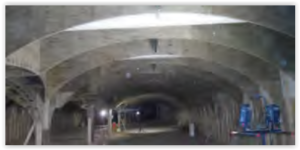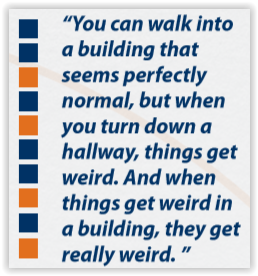Backstage Pass to Back of the House
THE ODD, UNUSUAL, AND FASCINATING THINGS I SEE ON THE JOB
 On my surveys, I get to see a lot of weird “back of the house” stuff. In most buildings, back of the house means air-conditioning units or kitchens. In my line of work, where I investigate unusual locations, back of the house can mean something a lot more interesting.
On my surveys, I get to see a lot of weird “back of the house” stuff. In most buildings, back of the house means air-conditioning units or kitchens. In my line of work, where I investigate unusual locations, back of the house can mean something a lot more interesting.
Some months ago, a tornado ripped the A/C unit off the top of a border crossing station, causing the building to flood. I came in several times over the course of three weeks to help make sure the water damage had been properly cleaned up and to check for mold. In the past, I’ve mentioned how tricky water can be. When I conduct these inspections, I’m allowed to go anywhere in the building to look for missed water damage, and thus, I get to see things few people get to see.
While I was at the station, I got to watch FDA staff do inspections on various fruits and vegetables coming across the border. I also spoke with border patrol agents about how they conduct inspections and saw the specialized equipment used to X-ray semitrucks. These machines are used to search for illicit drugs being smuggled across the border. Not exactly Area 51, I know, but I appreciated the new perspective. I never realized how hard these people work at border crossing stations and how dedicated they are to their jobs.
Government buildings don’t often surprise me, though I do enjoy seeing the inner workings of some of these buildings. There are some locations in the private sector, however, that do catch me off guard. You can walk into a building that seems perfectly normal, but when you turn down a hallway, things get weird. And when things get weird in a building, they get really weird.
 In the early summer, I got a phone call from an engineer friend of mine I hadn’t spoken to in almost 15 years. He told me about a client he was working with who had problems with a new, high-end country club that had just opened. There were complaints of unusual odors, and they weren’t sure of the source. The country club was located in an old building from 1961, which the client purchased from a now-defunct oil company. They wanted me to check each room in the building and figure out what the problem was.
In the early summer, I got a phone call from an engineer friend of mine I hadn’t spoken to in almost 15 years. He told me about a client he was working with who had problems with a new, high-end country club that had just opened. There were complaints of unusual odors, and they weren’t sure of the source. The country club was located in an old building from 1961, which the client purchased from a now-defunct oil company. They wanted me to check each room in the building and figure out what the problem was.
And there’s another area of the building we’d like you to take a look at,” my friend said before we got off the phone.
“Oh yeah?” I asked. “Where exactly?”
“The nuclear fallout shelter.”
At some point, a lot of my peers decided that if a building was weird or unusual, they should call me. I don’t know how they came to this conclusion, but I’m not complaining. I love a challenge. Take the country club, for example. How often do you get the opportunity to explore a nuclear fallout shelter built in the 1960s? The club has plans to renovate the space into something else, so I was lucky I had the opportunity to see the shelter for myself. Most of the people in the country club had no idea what was just beneath their feet!
These “back of the house” tours are the most unexpected perks of my job. It’s like a backstage pass to see the unusual secrets of the most inconspicuous buildings. Once you see what’s hiding in some places, the way you look at the world changes.

